If you've never made tofu but the idea intrigues you, Jung Eun Chae's takes you through all the steps, and at the end, you'll have both fresh tofu and use for the leftover pulp - her recipe for .
Chae - who gathered a keen following when she opened her tiny Melbourne apartment to just six diners, four nights a week, back in 2019, was then named Gourmet Traveller's Best New Talent for 2021, and has won more accolades since moving her to rural Victoria - makes almost everything from scratch in her home kitchen, including tofu. Her new book, Chae: Korean Slow Food for a Better Life, takes readers through four seasons of recipes, with a focus on thoughtful, minimal-waste cooking (such as the shown below).

From the book: Tofu, mushroom and perilla seed porridge. Credit: Armelle Habib / Hardie Grant Books
"Most Korean food is easy to make but the processes are long and you need to plan ahead. For example, the nigari (coagulant) that’s used to make tofu is created by harvesting fresh sea salt. We put it in a big bag, snip the lower corners, and, after months (and years) the seawater slowly drips through and can be used to form tofu. Luckily, you can also purchase it in liquid or powder form," she writes in the book, while sharing her recipe for tofu.

The first steps of tofu making Credit: Armelle Habib / Hardie Grant Books
The process (detailed recipe ) begins by soaking 200 g of dried soybeans for 8 hours, then blending with fresh water. The puree is then poured into a cloth and squeezed to extract the milky liquid, as shown above. More water is added and the pulp is squeezed thoroughly again.
That will leave you with soy milk - used for making the tofu - and some ground soybean pulp, which you can turn into a delicious comfort food bowl, her .

Ground soybean stew with pork. Credit: Armelle Habib / Hardie Grant Books
The soy milk is then transferred to a pot and simmered for 15 minutes, after which perilla oil and salt are added. "Perilla oil not only prevents foaming but also enhances the rich, savoury flavour," she explains. Next, nigari is added, and the milk simmered for a few more minutes.

Making tofu - next steps. Credit: Armelle Habib / Hardie Grant Books

Tofu making - moving along. Credit: Armelle Habib / Hardie Grant Books

Tofu making - final steps. Credit: Armelle Habib / Hardie Grant Books
Photography by Armelle Habib.
Get the recipe

Tofu








